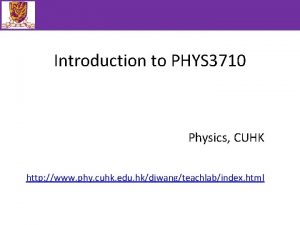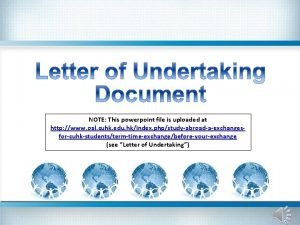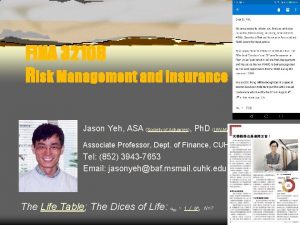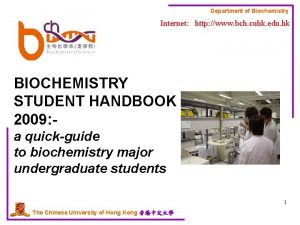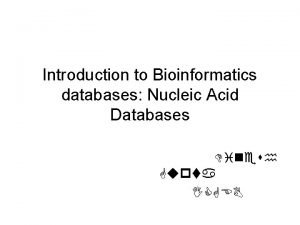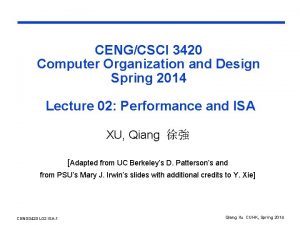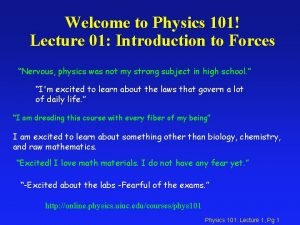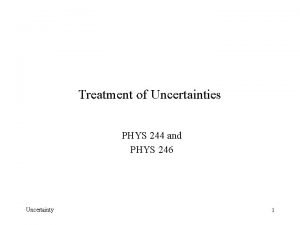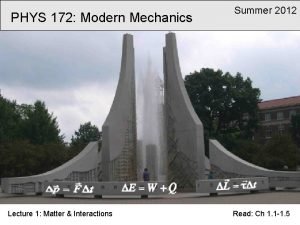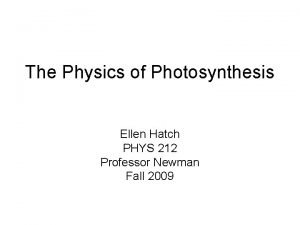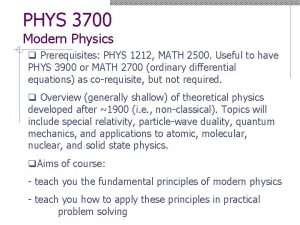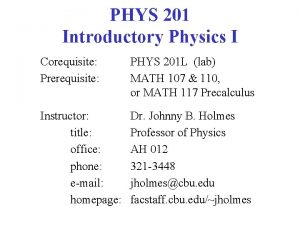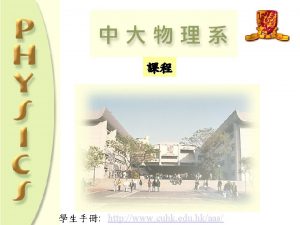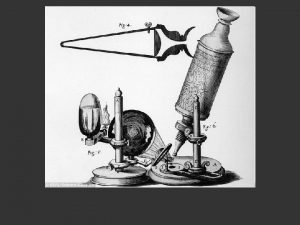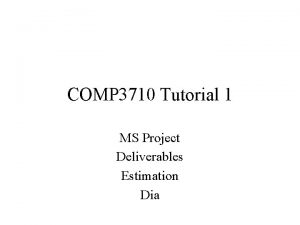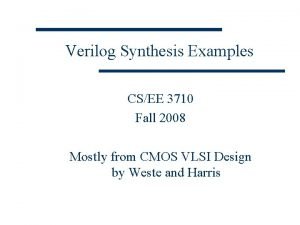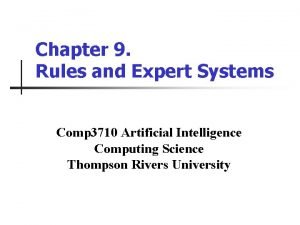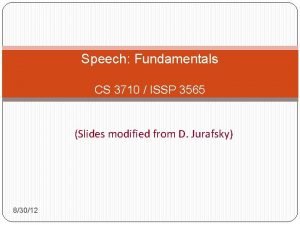Introduction to PHYS 3710 Physics CUHK http www




























- Slides: 28

Introduction to PHYS 3710 Physics, CUHK http: //www. phy. cuhk. edu. hk/djwang/teachlab/index. html

Outline 1. About this course 2. The special schedule 3. Some detailed requirements: lab notebook, data analysis, report writing 4. Assessment scheme 5. Lab safety reminder

Teaching team Professors: Yilin Wu, Dajun Wang Swee-Kuan Goh, Lei Xu Technician: Gary Lai TAs: Ruoqi Ai, Zhen Chen, Guanghua Chen, Xinxin Xia, Mucan Jin, and Jianyu Xie

Background • Physics is an experimental science, but there were only two lab courses in our old curriculum. • Previous teaching lab courses (Lab I and II) provides only basic skills but didn’t prepare our students for real scientific research and work. • No independent experimental project learning opportunities for students in the old physics curriculum.

Purpose • Provide an opportunity for students to experience the whole process of scientific research. • Skills to pick up: ü Independent learning, ü reading skill (to read some references at the beginning), ü time-management skill (keep track of the progress in taking data), ü honesty and organization (honest and organized to the data taken), ü data analysis, ü drawing conclusions from data, ü communication skills (scientific writing or/and oral reporting, discussions with instructors), ü Eventually, a systemic way of working on a new scientific problem.

Basic structure • 1 -unit; compulsory for year-3 students; • It is offered in the 1 st term and the 2 nd semesters; • One short experimental project to finish independently, which illustrates modern physics and/or experimental technique; • For each project, a student should plan to work in the lab for at least 5 days, but no more than 10 days • Prerequisite: PHYS 1712 and 2711; special permission of the instructor otherwise.

Projects 1 2 3 4 5 6 7 8 Special rel. C 60 Radiometer Rutherford Muon Cavity NMR Diodes CCD High Tc YBCO Brownian Nuclear detector Coupled Osc. Soliton Heat engine Cu-Ni alloy 1. Modern physics and nuclear physics: special relativity, Rutherford scattering, nuclear detector, muon lifetime 2. Solid state physics: C 60, High Tc Superconductor YBCO, magnetic properties of Cu-Ni alloy 3. Optics and electronics: optical cavity, ccd, diodes, Brownian 4. Other: radiometer, NMR, water soliton, coupled osc. , heat engine, saturation spectroscopy

Outline 1. About this course 2. The special schedule 3. Some detailed requirements: lab notebook, data analysis, report writing 4. Assessment scheme 5. Lab safety reminder

The schedule: a very difficult situation We are allowed to have face-to-face teaching, with special permission from the university. However, no lab sessions are allowed in September.

Schedule: this week Each project will be offered 3 times (except some with time conflicts due to instruments sharing); One person per slot; 1. Make your choice before end of this Friday and mark your name in room 216 (need to come in person).

Choose a project slot within this week

Schedule: September Reference reading and remote discussion 2. Find out the TA and professor in charge of your project. 3. Contact the Mr. Gai for the lab manual and references (E-copy). 4. After studying the documents, make an appointment and discuss with the professor in charge of your project within this month. 5. During the discussion, you should show your understanding and plan including your working schedule of the selected project. 6. Can’t start the experimental part without the Prof’s approval. 7. Zoom links will be sent to you only after receiving the appointment request.

Teaching team duty distribution

Schedule: Lab sessions 5. Lab sessions start from October 5: each group should finish the project, including preparation, data taking and analyzing within 2 weeks starting from the designated date 6. Another one weeks for report writing. The professors offer a proof-reading opportunity for your draft report if the report is submitted 3 days before the due date.

Schedule: note to lab sessions ü You need to follow your planned schedule: otherwise no one can follow and help you. ü Try to get things done with maximum independence: think hard enough before asking for help, but don’t hesitate to ask for help. ü TAs, technician and professors are available, but you need to make appointments in advance. ü Running experiment after 5: 30 pm alone is not allowed: university rule. In special cases, you need to make arrangement with TAs in advance.

Outline 1. About this course 2. The special schedule 3. Some detailed requirements: lab notebook, data analysis, report writing 4. Assessment scheme 5. Lab safety reminder

Lab notebook ü It is one of the most important part of this course ü It should be in a detailed, organized, dairy style and reflect the real-time progress of the project ü It should include, but not limited to these: physics understanding of the project in your own words, overall procedure, experimental schematics, records of experimental parameters, plots of raw data, details of your analysis, results and conclusions ü All contents on the notebook should be permanent, including mistakes (marked by strikethrough lines) ü Handwriting should be legible (to you and to others) ü It should be submitted together with your report ü Ask Mr. Gary Lai for the notebook itself when choosing your project

Data analysis • One of the most important parts of scientific research: in many cases, data analysis takes more time than data taking! • One common mistake: show lots of raw data without any analysis! • Others: errors misrepresented, units missing


Lab report • • Journal format: Physics Review (A, B, C, D) Latex is suggested (visit www. sharelatex. com); Word is ok but harder to work with for journal papers. We can provide help for first time users. Organization: not fixed, just an example Title: Author and affiliation: Abstract: Main text in sections (just an example!): 1. Introduction 2. Theory 3. Experiment 4. Results and discussions 5. Conclusion Acknowledgements

Lab report: common mistakes • Wrong format: harder to follow Physical Review format without using Latex • Abstract: duplication of the first and last sentences of the main text! • References: not in place • Figures: without post-processing, without clear labels (with units) and marks • Figures: too many. A series of measurements with only one changing variables should be compiled together to form one figure, if you want to show them. • Figures: captions too simple. Everything shown should be explained clearly.

Outline 1. About this course 2. The special schedule 3. Some detailed requirements: lab notebook, data analysis, report writing 4. Assessment scheme 5. Lab safety reminder

Assessment scheme Submit the lab report, the raw data and the lab notebook to the professor in charge of your project. Submit in person or by email! Don’t use the box in the 2 nd floor! Not only the report

Assessment scheme: more details We have 4 professors now. To make sure the grading is more uniform, we will use a more detailed marking scheme.

Assessment scheme: criterion referencing Grade Descriptors A : Demonstrate thorough mastery of the subject (of the project or seminar) required for attaining all the course learning outcomes. Demonstrate evidence of original thoughts and the ability of critical use of data or results to draw insightful conclusions, in a manner that would surpass the normal expectation at this level and standards that may be required at higher levels of study or research. Has the ability to express the knowledge and synthesis of ideas in a clear and cogent manner. A- : Demonstrate substantial command of the subject (of the project or seminar) required for attaining almost all the course learning outcomes. Demonstrate the ability of critical use of data or results to draw meaningful conclusions, in a manner that is logical and comprehensive. Has the ability to express the knowledge or application with clarity and accuracy. B : Demonstrate general and sufficient command of the subject (of the project or seminar) required for attaining most of the course learning outcomes. Demonstrate the ability of the use of data or results to draw mostly correct conclusions, in a manner that is logical and persuasive. Has the ability to express the knowledge or application in a satisfactory and unambiguous way. C : Demonstrate general command of the subject (of the project or seminar) required for attaining some of the course learning outcomes. Demonstrate the ability of the use of data or results to draw conclusions, but with occasional errors. Has the ability to express the separate pieces of knowledge in an unambiguous way. D : Demonstrate partial command the subject (of the project or seminar) required for attaining some of the course learning outcomes. Has limited ability to use data or results to draw conclusions. Has the ability to state the knowledge in simple terms. F : Demonstrate little or no evidence of command of subject (of the project or seminar) required for attaining the course learning outcomes, OR failure to meet specified assessment requirements.

Outline 1. About this course 2. The special schedule 3. Some detailed requirements: lab notebook, data analysis, report writing 4. Assessment scheme 5. Lab safety reminder

Last but not the least: Lab safety issues Extremely hazardous radiation: Nuclear, x-ray Chemicals: some solvents Electromagnetic radiation: lasers, radio and microwave frequency Low temperature: LN 2, He High temperature: furnace HV and UHV Vacuum Make sure you understand the standard operation procedure in dealing with these; If you feel uncertain about any thing of these: stop and ask for help

Thanks!
 Cnaf 3710 weather minimums
Cnaf 3710 weather minimums Scp 3710
Scp 3710 Phys3710
Phys3710 Cuhk physics
Cuhk physics Single slit envelope
Single slit envelope Http //vsg.quasihome.com
Http //vsg.quasihome.com Cuhk assistant professor salary
Cuhk assistant professor salary Pgde cuhk
Pgde cuhk Cuhk astronomy
Cuhk astronomy Cuhk lib
Cuhk lib Chinese university of hong kong library
Chinese university of hong kong library Alnsider
Alnsider Cuhk shb
Cuhk shb Eclt cuhk
Eclt cuhk Cuhk ppt template
Cuhk ppt template Cse fyp
Cse fyp Fina 3210
Fina 3210 Cuhk biochem
Cuhk biochem Bb.cuhk.edu cn
Bb.cuhk.edu cn Thomas cheung school
Thomas cheung school Cuhk bioinformatics
Cuhk bioinformatics Cpii cuhk
Cpii cuhk Phys 102 uiuc
Phys 102 uiuc Physics 101 uiuc
Physics 101 uiuc Phys courses ucsd
Phys courses ucsd How to calculate experimental uncertainty
How to calculate experimental uncertainty Purdue physics 172 past exams
Purdue physics 172 past exams Physics 241 purdue
Physics 241 purdue Phys 212 equation sheet
Phys 212 equation sheet


